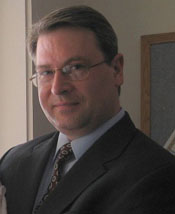
David Barondeau
Associate Professor
My group couples X-ray crystallography with molecular biology, biochemistry, spectroscopy and biophysical methods such as small angle X-ray scattering and deuterium exchange mass spectrometry to understand the chemistry underlying biological mechanisms. Students have opportunities for collaborative interdisciplinary research, X-ray data collection at national synchrotron facilities, and participation in international meetings and symposiums.
The Barondeau research group greatly benefits from the service facilities of the ILSB. The group particularly benefits from the structural biology infrastructure included in the building, including the X-ray, mass spectrometry, and microscopy facilities. Interactions with the other structural biology groups from across campus result in an exchange of ideas, enhanced problem solving, and increased productivity.
Eukaryotic Fe-S cluster biogenesis
Metal ions are required for many biochemical reactions, but are also a major source of toxic byproducts called reactive oxygen species.
Humans have specific protein escort and storage systems that minimize this undesired reactivity. Defects in one of these systems, Fe-S cluster biosynthesis, are correlated with mitochondria dysfunction and implicated in neurodegenerative diseases (such as Parkinson's and Alzheimer's), genomic instability (which leads to cancer), and heart disease. The Barondeau group is studying the mechanism of how these escort proteins work together to make functional proteins and how defects in these systems lead to toxic byproducts and human disease.
Novel Oxygen-tolerant [FeFe] Hydrogenase
The development of low-emission fuels is one of the greatest challenges facing our society. An ideal solution would be to capture light energy from the sun and then store and transfer this energy in the form of hydrogen gas. Toward that end, enzymes known as hydrogenases that produce hydrogen can be engineered into photosynthetic green algae or cyanobacteria. But sustained hydrogen production is currently limited because oxygen, which is generated during photosynthesis, inactivates hydrogenase. To address this problem, the Barondeau group has identified and is now characterizing a novel class of hydrogenase that may be more resistant to oxygen inactivation.
DNA Repair in Sporulating Pathogens
A current human health challenge is the ability of certain pathogenic bacteria to form spores, which are impervious types of cells that can survive for millions of years. Examples of such bacteria include Bacillus anthracis (which produces anthrax toxin), Clostridium botulina (results in botulism), and Clostridium perfringes (the "flesh-eating bacteria" that induces gas gangrene). In the spore state, these pathogens are remarkably resistant to typical biocidal agents and ultraviolet radiation. The Barondeau group is investigating how these pathogens are able to overcome UV-radiation and repair their DNA.
B.A., 1989, Southern Utah State College
Ph.D., 1996, Texas A&M University
Fellow, 1997-1998, La Jolla Interfaces in Sciences
Postdoctoral Fellow, 1998-2000, NIH
Senior Research Associate, 2002-2006, The Scripps Research Institute